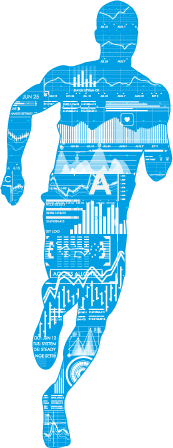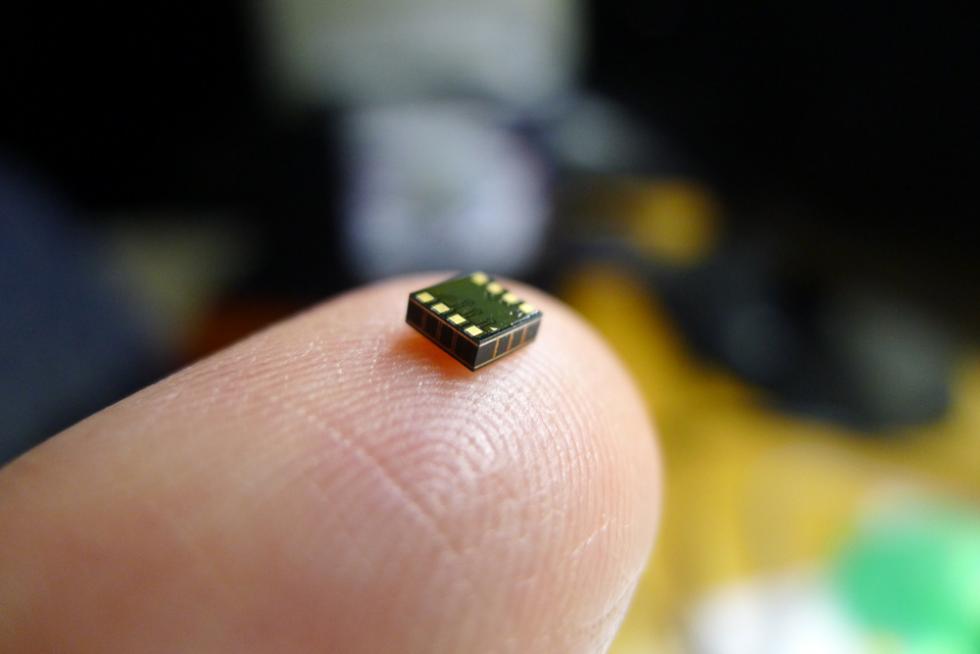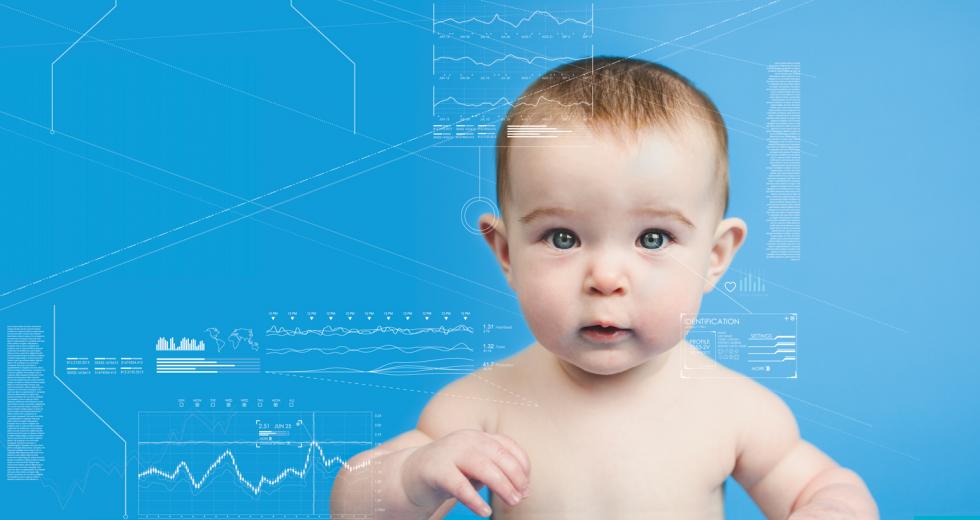Imagine a piece of technology the size of an aspirin. It can go anywhere, be embedded in anything and keep track of any action, movement or sound — imparting huge amounts of data, like tiny puzzle pieces that can be correctly fitted to form the picture of your life. It sounds Orwellian, the ability to monitor your habits at all times.
Of course, we’re talking about sensors: tiny monitors that can fit anywhere and impart data bytes beyond any degree engineers of the first computers could have imagined. The technology brings with it both wildly beneficial applications and serious privacy concerns. It is unstoppable, and most people don’t even know its name: The Internet of Things, the newest phase of computing, refers to the interconnectivity between humans and the digital world.
Smart Future
When the Electronic Numerical Integrator and Computer — more commonly, known as ENIAC, the world’s first general-use computer — was introduced in 1946, it was 100 feet long, used more than 17,000 vacuum tubes, had more than five million hand-soldered joints and weighed nearly 30 tons.
In 1971, the world’s first personal computer, the Kenbak-1, was advertised for $750 in Scientific American. It had a 256-byte memory and the company sold just 40 machines before going under two years later — but the technology spawned a legion of desktops during the tech bubble of the ‘80s and ‘90s, like the Commodore PET and the Apple I.
Exactly 20 years after the Kenbak-1, 1993 saw the debut of the IBM Simon Personal Communicator. Though the term “smartphone” wouldn’t be coined for another several years, the IBM Simon was handheld, featured a touchscreen and had only one application that cost more than $3,000 to install. (For comparison: In 2016, the typical app costs about a dollar, and there are about 1.4 million of them available just in Apple’s App Store.)
There has always been a smart future, since the day inventor Charles Babbage laid down initial plans for a “difference machine” in 1822. Computational intelligence has evolved from a giant machine operated by a team, to one that can fit on your desk or lap, to one that can be held in your hand. These leaps were all made in about 20-year gaps, representing first the standalone phase, then the personal computer phase, followed by the advent of mobile technology, and now the IoT. Each wave of computational technology towers in achievement above the others, and all in a relatively short time period. This kind of rapid innovation in manufacturing and technology has not been seen since the advent of the steam engine and the Industrial Revolution, when steam engines changed the entire world.
Smart Body
Do you use a FitBit or a Fuelband? Do you track your heart rate with a monitor when you work out? Maybe you clip on a pedometer, or use an app on your phone and compete with a friend to see who walked the most steps that day? If so, you’re already participating as an early-adopter in the most ubiquitous first wave of the IoT: smart wearables.
(Illustration by Darren Ragle)

“We can measure your cadence, your revolutions per minute … heart rate and beats per minute, individualized to the person’s physiology, zone they’re in, time in zone, calories burned and percent of time in each of these zones,” says Sally Edwards, an ultra-marathoner and CEO and founder of Heart Zones — a Sacramento-based company that uses smart wearables to motivate and empower customers to take control of their fitness goals. Edwards says evidence shows that “data-driven decisions” (when an individual or the group has data and biofeedback on how they are doing) lead to more activity. “That’s what we want,” she says. “We want people to move more.”
Individualized data allows humans to build a connection with their technology and trust it to prescribe solutions. Edwards says that prescription is essentially making a deal with your technology. For example, “The deal was that every 30 minutes you were going to do chair squats for two minutes,” she explains. “You’re giving that information to the app and then having the app be your coach, be your consultant and support you in being successful.”
Prescription plays on the same psychological pleasure and confirmation we receive when the iPhone’s Siri remembers who our mother is when we tell her to “call mom,” or Google Maps remembers where we went and finds the location again with a minimal prompt.
Smart Buildings
Local company, Smart Grid Billing, uses sensors to monitor and control the 500 rooms at the Hyatt Regency in downtown Sacramento. Founder and CEO Henrik Westergaard can pull up a 3D model of the hotel on his computer to see which room had its door opened, the utilities turned on, the temperature changed or if people are just moving around the room — accurate within a 37th of a millisecond. They also have similar contracts with the Embassy Suites in Sacramento, a Marriott in Texas and a Hilton in Boston.
According to Westergaard, by using the sensors to monitor energy use and adjust by only a few degrees, they were able to save the Hyatt Regency from spending 200 kilowatts per hour at the peak of the day. “We have a rule in place that after 9 o’clock in the morning, all the rooms that are empty, we’ll set back the set points on the thermostat,” he says. And as an unexpected result, the hotel now saves five tons of water every month previously used to cool the air conditioners. “But that’s just getting us in the door with the hotels,” Westergaard continues. “What we found out afterwards was this changes the whole way they do business in general.”
Westergaard can pull up the 3D model, focus on the specific floor and find the data coming in from a certain room. Perhaps he sees a switch turned on but no power being used — the sign of a missing or dead lightbulb. Then when the sensor indicates a door just closed but there’s no movement in the room, staff can exchange the defective bulb without disturbing the occupant. “The whole way they do stuff, the engineering, is more preventative than reactive now,” Westergaard says. “It gets fixed before it even gets noticed.”
Westergaard says the market will see more options for residential buildings in the very near future. “If we can control 1,500 devices at a Hyatt,” he says, “we should be able to control a home as well.” In fact, Westergaard is already using sensors to keep tabs on his grandmother: “She’s 100, living by herself in a kind of assisted living, and sometimes she forgets to shut off the kitchen sink,” he says. “So you put this in and a little sensor on the floor, and if the water starts running onto the floor it will automatically shut off the water — and notify myself and the staff on site. No more flooding of the neighbor.”
No wires, no battery to recharge — a digital Pinocchio, with no strings to tie it down.
Smart Environment
In October of 2015, UC Davis Professor of Mechanical and Aerospace Engineering David Horsley and his team were awarded a $1.8 million grant by DARPA — the U.S. Defense Advanced Research Projects Agency — to work on ultra low-power sensors. These sensors could last for years, feeding information back to a database about everything from your heart rate to when you take out the trash or put a pill bottle back on the shelf. “They’re small devices, much smaller than your cellphone, with a network connection to communicate to a hub,” Horsley says.
Horsley says sensors are the most integral feature of the IoT. “The sensor is always on. There’s some amount of computational intelligence, some way of getting that data to you so you can see it,” Horsley says. Unlike a smartphone that constantly needs to be recharged and taken away from its data source, Horsley’s sensors can be anywhere at any time, constantly sending data back to a machine that interprets it for our use. No wires, no battery to recharge — a digital Pinocchio, with no strings to tie it down.
Related: Real-World Application of the Internet of Things
For example, the sensors already inside your current smartphone require about 10 milliwatts to run. Horsley’s DARPA-funded sensors seek to operate in the nanowatt range — one million times less energy than today’s sensor technology. “It will be something that is a lot smarter than a smartphone,” Horsley says. “Tiny devices that you stick around your house or something that you’re near. We are very close to this.”
At Berkeley-based CHIRP Microsystems, Horsley is also working on producing sensors that respond to 3D actions, using hand motions to bounce back an ultra-low audio wave. These sensors will run all the time, monitoring your every move for an action that tells them to turn on or be aware of a command. In a product video for CHIRP, Horsley waves his hand in front of an iPad to wake it up and flips the pages of a book, without ever touching the screen. There will be hundreds of these sensors in your everyday life, he says. “Take the cellphone industry, there are a billion sold every year, but I could have 20 of these sensors in my house, I could even be wearing three or four different things,” Horsley says. When asked about a potential future of embedding these sensors into people’s bodies, Horsley gets a little wary, and says he dislikes that topic and the words “DARPA-funded” in the same sentence. “No one wants the idea that we’re being monitored all the time,” he says. “So if there’s all these sensors around us, it should be in ways we’re comfortable with.”
Smart Security
With so much personal data available — like when your heart beats or when you breathe, where you go and how long you’re there — there are obvious security concerns regarding who can access that data. Ultimately, where do the random puzzle pieces of our lives end up — and how can we trust people with that information when we don’t even know them?
“Once you’ve connected everything up, you’ve made it open and transparent,” says Marc Musgrove, director of the Internet of Things and Digital Industries PR at Cisco, from his office in Rancho Cordova. “You can’t just have anyone showing up with a PC and plugging into that without being able to control it.” True security is in the ability to keep that information within a protected space. Musgrove says Cisco is working on ways to keep private IT networks separate from the global IoT infrastructure.
UC Davis professor David Horsley balances one of his ultra-small,
ultra-low power sensors on the pad of his finger. He and his team
at CHIRP Microsystems in the Bay Area are working to build
sensors that are increasingly smarter and smaller.

Josh Morgan, a senior vice president at Edelman in Sacramento and a cybersecurity expert, recommends all clients begin with an audit of potential security risks. Try to bring someone in that can poke holes in your system and find access points that you may not have thought of, he says, adding that companies need to make sure to address concerns on behalf of consumers who may not recognize the inherent risks. Say you have a webcam for home security: “Can other people look into your living room?” Morgan asks. “Is it the company’s need to make sure that it’s secure or is it yours as the consumer?” Businesses should make sure their consumers are aware of the risks of a service, he says, because it lessens the security risks. Lest you think this is a problem for the future, there are already dark corners of the internet devoted to finding and watching hacked webcams. In April of this year, even FBI Director James Comey admitted he puts a piece of tape over his laptop webcam.
It’s safer, Morgan says, for a business to assume the responsibility, because in all likelihood, the consumer won’t. We often expect companies to tell us of the risks we assume when using a product, so why treat technology differently? “With how fast this market is moving, the customers are not always going to know the information they need, and the companies that can predict that will come out ahead,” Morgan says.
And there’s the rub. Most consumers focus on convenience, not privacy concerns. “In major applications right now, privacy is taking a backseat to utility and convenience,” Morgan says. “That is traditional at the beginning of technology adoption curves. The focus is on making it as easy to use as possible and then locking it down afterwards.”
The IoT isn’t a Jetsons-like future; it’s here now — used to save lives, improve the environment, make your job easier, and save time and energy. Every time you type in your email address, post a comment on a website or download information from your GPS, you’re sending out puzzle pieces of yourself into the world. While there is a lot of data noise in that world, people and machines with the right skills can hone in on your frequency and start putting those pieces together. Eventually, that puzzle becomes a picture of you, where you live, what you do, the daily things you use and that which you love.
Welcome to the internet of you.



